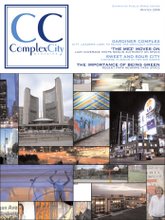My home has no walls
 BY D. LAXMIDAS MAKWANA
BY D. LAXMIDAS MAKWANA
Waking up to the sounds of morning rush hour traffic on the Don Valley Parkway isn’t something Lester Labradore expected when he moved from his rent-controlled apartment in Ottawa to find work in Toronto.
Today, Labradore sleeps between two waterproof sleeping bags in a tent on the edge of the bustling roadway. He starts his day with a drink and then begins his daily trek to a liquor store near Broadview and Danforth Avenues where he panhandles in hopes of saving enough money to rent an apartment.
Labradore considers the square metre of sidewalk cement to the left of the store’s entrance his office. On a sunny day he’ll spend over 10 hours sitting on a weathered cushion while keeping a close eye on a maroon baseball cap for spare change passersby.
For Labradore, living and working in public areas north of Toronto’s heavily policed downtown core is his right as a citizen of the city.
“It’s a public sidewalk,” Labradore said. “If I’m not going out of my way to cause someone grief and make their day bad, then I have a right to a sidewalk just as much as they do.”
But Labradore knows the law says otherwise. Toronto’s six-year-old-Safe Streets Act requires police to arrest individuals panhandling near bank machines, bus shelters and other public areas. Critics of the bylaw say it is only enforced in the downtown core to maintain an appearance of prosperity without addressing homelessness.
John Clarke, director of the Ontario Coalition Against Poverty see these clashing rights as the unresolved argument over accessibility to Toronto’s public space.
“There is an overwhelming argument of necessity,” he said. “If you find yourself homeless then you may need to sleep in a park, you may need to sleep in an intersection, you may need to sleep on a heating grate, you may need to stand on a street corner and ask for money.
Clarke believes when this happens when society has to accommodate the people who it has forced onto the street.
Toronto’s Advisory Committee On Homeless And Socially Isolated People attempts to find a balance between maintaining the city’s overall aesthetics while resolving the economic needs of panhandlers. Former city councillor Jane Pitfield is on record saying city council is supporting initiatives that do little to find homes for the homeless and clean up public spaces.
“There has been a complacency making the problem an industry when there needs to be change,” she said. “Panhandling has become far too common and people who normally come into Toronto complain about how aggressive panhandlers can be. So now our neighbours in the 905 area won’t travel into the downtown core.”
Labradore knows that he can’t work downtown so he avoids the area and its politics entirely.
“If you go downtown you can’t even sit there for five seconds and the cops are right on you,” he said. “You’ve got bicycle cops, you got cars and you’ve got foot. Up here on the Danforth they don’t bother you unless you bother someone else.”
Clarke said that focusing on the downtown core separates claims to public space economically rather than ethically.
“In practice that claim (to public space) is stratified according to people’s economic situation,” he said.
Clarke points out that a movie production filming downtown paralyzes the city’s main traffic arteries, which in turn negatively affects area businesses and pedestrians. Clarke says because the city stands to make a profit the production is portrayed as a benefit rather than a problem.
Meanwhile Labradore maintains his claim to the spot in front of the liquor store but tries not to bother people. He is mindful of the bylaw so he tolerates pedestrians crowding his panhandling space on a busy Saturday afternoon.
“Sometimes you get snotty remarks and sometimes you get something. Then sometimes you get nothing,” he said.





No comments:
Post a Comment